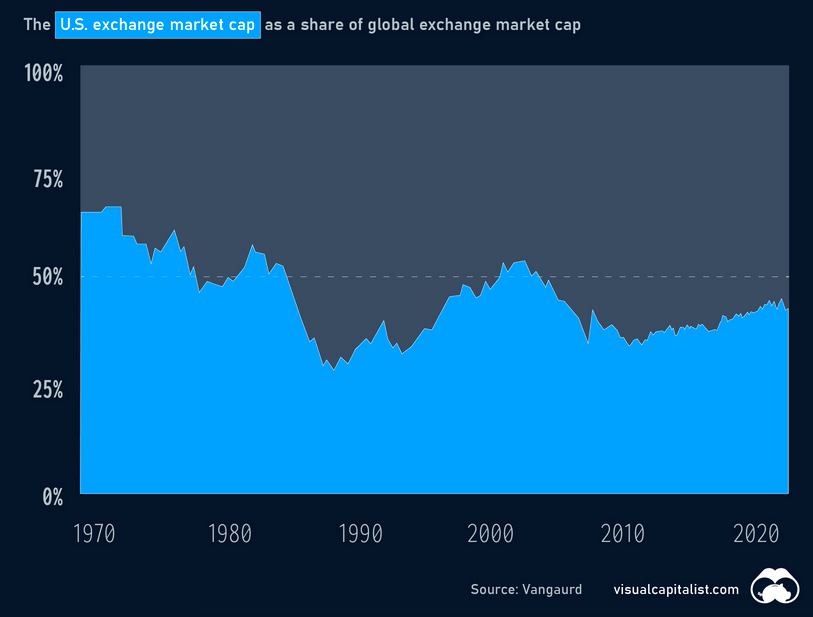
U.S. vs. International Stock Allocation
When it comes to the art of investing, one principle reigns supreme: diversification. This strategic approach involves spreading your investments across a variety of assets, sectors, currencies and geographic regions to reduce risk and potentially enhance returns. While diversification is essential for any investment portfolio, it becomes even more critical when considering stock allocation. In this blog post, we'll take a deep dive into the advantages of geographical diversification, the common home bias observed among American investors, the impact of global market shares, currency dynamics, and how seeking advice from local financial advisors can play a pivotal role in international investing success.
The Power of Diversification: Geographical Perspective
Geographical diversification is an investment strategy that strives to mitigate risk by distributing investments across different countries and regions. By doing so, investors can shield their portfolios from the upheavals of specific economies, geopolitical events, or market downturns. It's akin to not putting all your eggs in one basket. When one market experiences a setback, others might be flourishing, effectively balancing out potential losses and gains.
Home Bias: A Common Tendency
Ironically, despite the well-documented benefits of diversification, many American investors exhibit a strong inclination towards their domestic markets. This tendency is known as "home bias." Psychological factors, familiarity, and a sense of loyalty to one's own country's markets can contribute to this bias. However, embracing a home bias can lead to missed opportunities for growth. The global market is a vast expanse with diverse industries and companies not represented in the U.S. portfolio. To fully optimize returns, investors need to consider expanding their horizons.
International Markets: A Broader Picture
Here's an eye-opening fact: the U.S. stock market constitutes only about 45% of all global stock investments. This statistic underscores the immense potential of international markets that might be overlooked due to the home bias. By focusing solely on the U.S., investors may limit their exposure to the myriad of sectors, industries, and economic cycles present in other parts of the world. Diversifying across various geographic regions can provide access to untapped growth and diversification opportunities.

Currency Dynamics and Safe Havens
It's worth noting that currency dynamics can significantly impact international investments. The U.S. dollar (USD) has experienced a gradual loss in value over the years, particularly when compared to strong safe-haven currencies like the Swiss franc (CHF). This phenomenon underscores the importance of diversifying beyond the U.S. market. Investing in foreign currencies can offer a hedge against the potential further depreciation of the USD, ultimately contributing to a more balanced and resilient portfolio.

US Dollar Swiss Franc Exchange Rate (USD CHF) - Historical Chart from Macrotrends
The Role of Financial Advisors in International Investment
Venturing into international markets can be a labyrinth of regulations, cultural intricacies, and economic nuances. This is where the expertise of financial advisors specializing in the desired investment region becomes invaluable. Engaging a local advisor can provide insights inaccessible through mere research. They can offer guidance on market trends, potential risks, and emerging opportunities, empowering you to make well-informed decisions.
Investment Allocation to International Advisors
When considering allocation, it's prudent to earmark a portion of your portfolio—between 25% to 35% of your total wealth—to an U.S. Securities and Exchange (SEC) registered investment advisor outside of the U.S., depending on your wealth and goals. This approach combines the advantages of geographical diversification with the expertise of local advisors. Such a strategy not only broadens your investment horizon but also fosters a balanced portfolio that capitalizes on diverse markets' strengths.
In Conclusion
The debate between U.S. vs. international stock allocation underscores the critical role of geographical diversification in investment strategies. Overcoming the home bias, recognizing the global market's breadth, acknowledging currency dynamics, and seeking guidance from local financial advisors can substantially amplify the potential for long-term growth and portfolio stability. Remember, the global economy presents a wealth of opportunities, and tapping into them could be the key to a diversified and resilient investment journey.
Do you want to stay up to date on our blog posts and market outlooks? Sign up for our free market report sent out every six week: